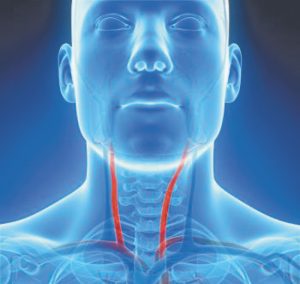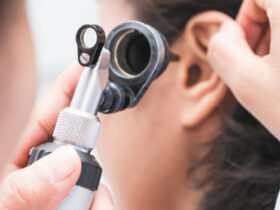By Jeffrey Edwards, MD, RPVI
 It is estimated that 30% of strokes in the United States can be attributed to carotid artery stenosis. The carotid arteries are two of the primary vessels that perfuse, or supply bloodflow to, the brain. Carotid stenosis is a condition where plaque buildup in the artery leads to narrowing in the artery, limiting bloodflow and increasing the risk for stroke due to embolization. This occurs when small blood clots or pieces of plaque block arteries within the brain.
It is estimated that 30% of strokes in the United States can be attributed to carotid artery stenosis. The carotid arteries are two of the primary vessels that perfuse, or supply bloodflow to, the brain. Carotid stenosis is a condition where plaque buildup in the artery leads to narrowing in the artery, limiting bloodflow and increasing the risk for stroke due to embolization. This occurs when small blood clots or pieces of plaque block arteries within the brain.
Risk factors for carotid stenosis include smoking, high cholesterol, high blood pressure, diabetes mellitus. In addition, if you’ve had prior radiation therapy of your head and/or neck then that may also increase your risk of developing carotid stenosis. If you’ve been diagnosed with coronary artery disease or peripheral artery disease, ask your primary care physician if you should be screened for carotid stenosis.
Carotid stenosis can be detected in several ways. It is possible to detect carotid stenosis on physical exam by hearing a bruit over the neck with a stethoscope. This is a sound created by turbulent flow across the carotid plaque. This may also be an incidental finding as it is not always associated with carotid plaque. Carotid ultrasound is a very sensitive test which can easily and reliably diagnose carotid plaque, and more detailed imaging can then be obtained with CT scan, MRI, or angiogram if needed.
Once a carotid plaque is identified, the plaque is monitored every 6 to 12 months with ultrasound to monitor for an increase in severity, as this tends to be a progressive condition. Carotid ultrasound is an effective, accurate, and inexpensive way to monitor carotid stenosis and ensure its stability. Taking antiplatelet medications, such as aspirin, and cholesterol-lowering medications like statins are essential to promoting plaque stability in carotid stenosis.
Surgery may be recommended if carotid stenosis is causes more than a 50% narrowing in the vessel and you experience a stroke or transient ischemic attack (TIA), sometimes called a “mini-stroke.”
If the narrowing progresses to more than 75% narrowing, your doctor may recommend surgery even if you have not suffered a stroke or TIA. In either case, the best medical therapy should be initiated, which includes aspirin and a statin medication to reduce cholesterol.
There are three primary types of surgery which are used to treat carotid stenosis. Carotid endarterectomy is a traditional open surgery during which your surgeon makes an incision on your neck in order to directly remove the plaque from the artery. Afterwards, a patch is often used to close the artery in such a way that the narrowing is less likely to recur. This has long been considered the gold standard modality of carotid artery surgery and is highly successful and safe.
Carotid artery stenting was first introduced in 1989. This minimally invasive alternative to carotid endarterectomy is performed through a puncture in the femoral (leg) or radial/brachial (arm) artery. In a carotid stenting procedure, your surgeon uses a balloon (angioplasty) and a stent to open and treat the carotid plaque. In order to prevent stroke during the procedure, a small filter is placed into the distal part of the artery to prevent plaque from traveling into the brain. This type of carotid stenting procedure is typically reserved for patients who are high risk for surgery due to prior carotid surgery, a history of neck surgery, or prior neck radiation.
Trans-carotid artery revascularization (TCAR) is a more recent development in the treatment of carotid stenosis. This is a “hybrid” procedure, in which traditional open surgery and minimally invasive endovascular techniques are utilized to place a carotid stent. During the TCAR procedure. Your surgeon makes a small (approximately 1-2 inch) incision just above your collar bone. Through this incision, your surgeon identifies the carotid artery and then proceeds to place a carotid stent while using a “flow-reversal” system. This system effectively prevents any bits of plaque from traveling into the brain during the procedure and captures this in a filter. This is a significant advance in technology which combines the safety and efficiency of a carotid stent with the efficacy of carotid endarterectomy.
Regardless of the treatment recommended, it is important to remember that diet, exercise, and avoiding tobacco products play a key role in the treatment of any cardiovascular condition. In general a low-cholesterol diet of mostly fruits and vegetables is recommended along with 30 minutes of exercise daily. Ask your doctor if you are at risk for carotid stenosis and would benefit from a referral to a vascular surgeon.
To schedule your appointment, please call 941-371-6565, or visit veinsandarteries.com to find out more.
Sarasota Vascular Specialists
941-371-6565
www.veinsandarteries.com










